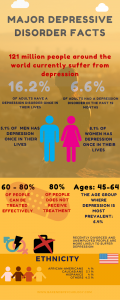Interesting Depression facts
Depression affects a lot of people nowadays. In fact it is one of the most common mental disorders in the world. Unfortunately, interesting depression facts are still unknown to the world. What is a fact and what is a myth? On this page you find interesting depression facts about Major Depression. Here you find answers to questions such as: Who is more likely to suffer depression: men or women? and more interesting depression facts.
For more information:
- Different types of depression.
- What are depression symptoms?
- Depression causes.
- Depression treatment.
- Coping with depression.
- Online counseling for depression.
- Take me to the homepage.
At Barends Psychology Practice counseling is offered for people suffering depression. Schedule your first, free of charge, session now, go to: contact us. (Depending on your health insurance, sometimes treatment can be reimbursed).
Interesting depression facts – Major depression and general.
- Depression is one of the most common mental disorders in the world [3].
- 32.6 to 35.1 million US adults (16.2%) suffer major depressive disorder at least once in their life [3].
- During the past 12 months 13.1 to 14.2 million US adults (6.6%) suffered from a major depressive disorder [3].
- In 2012 was estimated that 16 million adults in the U.S.A. had at least one major depressive episode (NIMH).
- In 2009, in the Netherlands, 5,2% of the people up to the age of 65 suffered from a depression (Trimbos Institute, The Netherlands).
- Annually approximately 10% of the Western population has a depression (Mental Health foundation).
- In the US, 8.1% of the women has a depression once in their life [3].
- In the US, 5.1% of the men has a depression once in their life [3].
- Middle aged (45-64 years old) people have a greater risk of developing depression (6.4%), due to a decline in testosterone [2].
- Depression is less likely among retired and/or Non-Hispanic black people [3].
(Advertisement. For more information, please scroll down.)
- Approximately 60 to 80% of the ones treated for depression show improvement within four to six weeks after starting treatment (therapy or medication) (farmacotherapeutischkompas).
- 72.1% of the people with life time major depressive disorder had at least one other mental disorder. Of these people 59.2% had an anxiety disorder, 24% a substance abuse disorder, and 30% an impulse control disorder [3].
- 64% of the people with major depressive disorder in the last 12 months had at least one other mental disorder. Of these people 57.5% had an anxiety disorder, 8.5% a substance abuse disorder, and 16.6% an impulse control disorder [3].
- 96.9% of the people with major depressive disorder in the last 12 months reported at least some role impairment associated with depression. Of these people 87.4% reported them as at least moderate, 59.3% as at least severe, and 19.1% as very severe [3].
- The work role domain suffered the least due to depression (only 28.1% reported severe or very severe). The social role domain suffered the most due to depression (43.4% reported severe or very severe) [3].
(Advertisement. For more information, please scroll down.)
- 57.5% of the people with major depressive disorder in the last 12 months received treatment. 51.6% of those people received Health Care treatment, and only 21.6% of those people received adequate treatment for depression [3].
- 80% of the people who have a depression also have suicidal thoughts. Over 90% of the people who die by suicide were diagnosed with depression or a depression type (webmd).
- People can suffer from a seasonal affective depression, such as winter blues, winter depression, summer blues or summer depression (psychiatry.org).
- The World Health Organisation (WHO) expects depression to become the second most important cause for “lost healthy years” in the year 2020 (WHO).
- People who had a major depressive episode in the past have an increased chance of 30% to experience another major depressive episode in the (near) future (this is called: recurrent major depressive disorder). After having a second major depressive episode chances to experience a third major depressive episode increase up to 75%, and after a third major depressive episode chances for a fourth reach 90%. The more major depressive episodes an individual experiences the more likely he or she is to experience another one in the future (nu.nl).
Interesting depression facts – literature:
- [1] Brees, Karen, K., 2008. The Everything Guide to Depression. Avon, MA: F+W Publications, Inc.
- [2] Barrett-Connor, E., Von Muhlen, D. G., & Kritz-Silverstein, D., 1999. Bioavailable testosterone and depressed mood in older men: the Rancho Bernardo Study. J. Clin. Endocrinol Metab. 84, 573-577.
- [3] Kessler R. C., Berglund, P., Demler, O., and others, 2003. The epidemiology of major depressive disorder. Results from the national comorbidity survey replication (NCS-R). JAMA, 23, 3095-3105.

